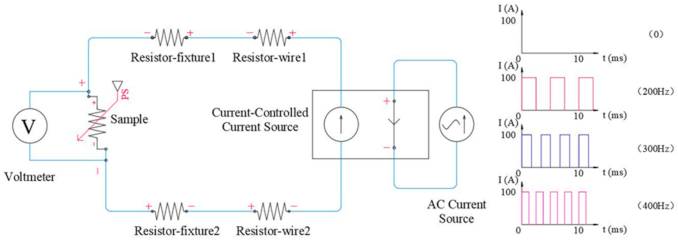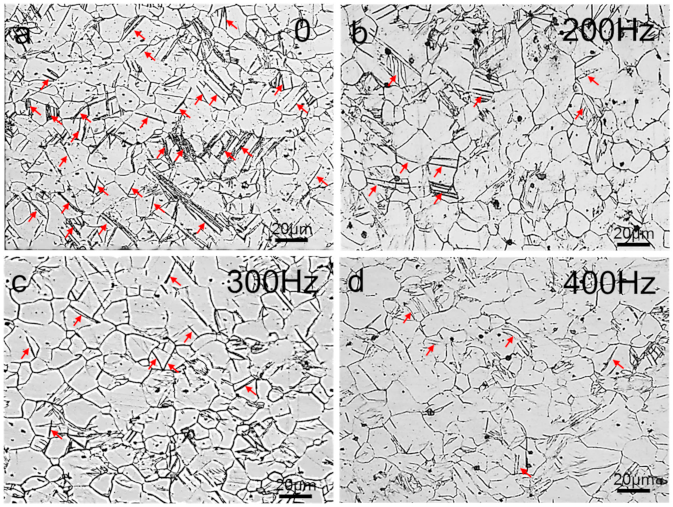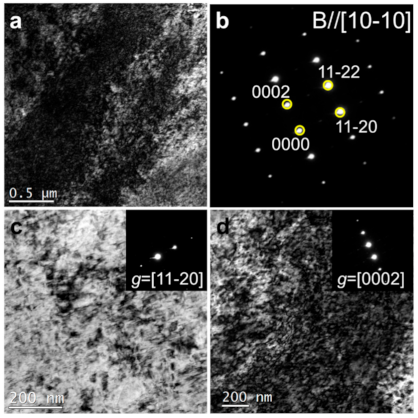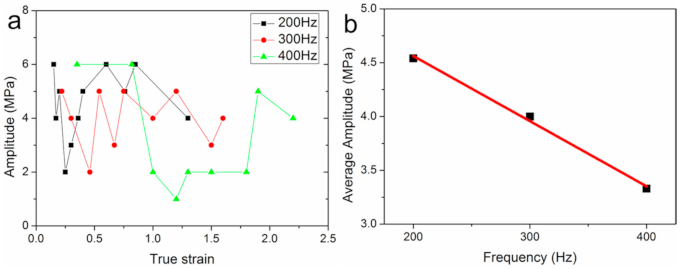Excellent Ductility in the Extruded AZ61 Magnesium Alloy Tube Induced by Electropulsing Treatment during Tension
Abstract
1. Introduction
2. Experiments
3. Results
3.1. Initial Microstructure
3.2. Tensile Properties
3.3. Work Hardening Behavior
3.4. Microstructure after Fracture
4. Discussion
4.1. Enhanced Ductility
4.2. Serrated Flow Phenomenon
5. Conclusions
Author Contributions
Funding
Institutional Review Board Statement
Informed Consent Statement
Data Availability Statement
Acknowledgments
Conflicts of Interest
References
- Hono, K.; Mendis, C.L.; Sasaki, T.T.; Oh-ishi, K. Towards the development of heat-treatable high-strength wrought Mg alloys. Scr. Mater. 2010, 63, 710–715. [Google Scholar] [CrossRef]
- Zhang, D.; Yang, Q.; Guan, K.; Li, B.; Wang, N.; Qin, P.; Jiang, B.; Sun, C.; Qin, X.; Tian, Z.; et al. A high-strength low-rare-earth-alloyed magnesium alloy via traditional hot-extrusion. J. Alloys Compd. 2019, 810, 151967. [Google Scholar] [CrossRef]
- Xu, Z.; Tang, G.; Tian, S.; Ding, F.; Tian, H. Research of electroplastic rolling of AZ31 Mg alloy strip. J. Mater. Process. Technol. 2007, 182, 128–133. [Google Scholar] [CrossRef]
- Yu, H.; Xin, Y.; Chapuis, A.; Huang, X.; Xin, R.; Liu, Q. The different effects of twin boundary and grain boundary on reducing tension-compression yield asymmetry of Mg alloys. Sci. Rep. 2016, 6, 29283. [Google Scholar] [CrossRef]
- Xiang, S.; Zhang, X. Dislocation structure evolution under electroplastic effect. Mater. Sci. Eng. A 2019, 761, 138026. [Google Scholar] [CrossRef]
- Zhao, S.; Zhang, R.; Chong, Y.; Li, X.; Abu-Odeh, A.; Rothchild, E.; Chrzan, D.C.; Asta, M.; Morris, J.M., Jr.; Minor, A.M. Defect reconfiguration in a Ti–Al alloy via electroplasticity. Nat. Mater. 2021. [Google Scholar] [CrossRef]
- Li, W.; Shen, Y.; Liu, H.; Wang, Y.; Zhu, W.; Xie, C. Non-octahedral-like dislocation glides in aluminum induced by athermal effect of electric pulse. J. Mater. Res. 2016, 31, 1193–1200. [Google Scholar] [CrossRef]
- Sheng, Y.; Hua, Y.; Wang, X.; Zhao, X.; Chen, L.; Zhou, H.; Wang, J.; Christopher, B.; Wei, L. Application of high-density electropulsing to improve the performance of metallic materials: Mechanisms, microstructure and properties. Materials 2018, 11, 185. [Google Scholar] [CrossRef]
- Conrad, H. Electroplasticity in metals and ceramics. Mater. Sci. Eng. A 2000, 287, 276–287. [Google Scholar] [CrossRef]
- Molotskii, M.; Fleurov, V. Magnetic effects in electroplasticity of metals. Phys. Rev. B 1995, 52, 15829–15834. [Google Scholar] [CrossRef]
- Okazaki, K.; Kagawa, M.; Conrad, H. An evaluation of the contributions of skin, pinch and heating effects to the electroplastic effect in titanium. Mater. Sci. Eng. 1980, 45, 109–116. [Google Scholar]
- Ghiotti, A.; Bruschi, S.; Simonetto, E.; Gennari, C.; Calliari, I.; Bariani, P. Electroplastic effect on AA1050 aluminium alloy formability. CIRP Ann. Technol. 2018, 67, 289–292. [Google Scholar] [CrossRef]
- Kim, M.-J.; Lee, K.; Oh, K.H.; Choi, I.-S.; Yu, H.-H.; Hong, S.-T.; Han, H.N. Electric current-induced annealing during uniaxial tension of aluminum alloy. Scripta Mater. 2014, 75, 58–61. [Google Scholar] [CrossRef]
- Kuang, J.; Li, X.; Zhang, R.; Ye, Y.; Luo, A.A.; Tang, G. Enhanced rollability of Mg-3Al-1Zn alloy by pulsed electric current: A comparative study. Mater. Des. 2016, 100, 204–216. [Google Scholar] [CrossRef]
- Jiang, Y.; Guan, L.; Tang, G.; Shek, C.; Zhang, Z. Influence of electropulsing treatment on microstructure and mechanical properties of cold-rolled Mg–9Al–1Zn alloy strip. Mater. Sci. Eng. A 2011, 528, 5627–5635. [Google Scholar] [CrossRef]
- Yiu, P.; Hsueh, C.H.; Shek, C.H. Rapid thermoplastic formation of Fe-based metallic glass foil achieved by electropulsing. Mater. Let. 2014, 136, 353–355. [Google Scholar] [CrossRef]
- Sun, Z.; Wang, H.; Ye, Y.; Xu, Z.; Tang, G. Effects of electropulsing on the machinability and microstructure of GH4169 superalloy during turning process. Inter. J. Adv. Manu. Technol. 2018, 95, 2835–2842. [Google Scholar] [CrossRef]
- Liu, F.; Zhang, D.T.; Chen, D.L. Enhancing mechanical properties of AZ61 magnesium alloy via friction stir processing: Effect of processing parameters. Mater. Sci. Eng. A 2020, 797, 139945. [Google Scholar]
- Niu, X.; Lia, G.; Zhang, Z.; Zhoua, P.; Wang, H.; Zhang, S.; Cheng, W. Simultaneously improving the strength and ductility of extruded bimodal size SiCp/AZ61 composites: Synergistic effect of micron/nano SiCp and submicron Mg17Al12 precipitates. Mater. Sci. Eng. A 2019, 743, 207–216. [Google Scholar] [CrossRef]
- Afrin, N.; Chen, D.L.; Cao, X.; Jahazi, M. Strain hardening effect of a friction stir welded magnesium alloy. Scr. Mater. 2007, 57, 1004–1007. [Google Scholar] [CrossRef]
- Kim, M.-J.; Yoon, S.; Park, S.; Jeong, H.-J.; Park, J.-W.; Kim, K.; Jo, J.; Heo, T.; Hong, S.-T.; Cho, S.H.; et al. Elucidating the origin of electroplasticity in metallic materials. Appl. Mater. Today 2020, 21, 100874. [Google Scholar] [CrossRef]
- Chen, X.H.; Lu, L. Work hardening of ultrafine-grained copper with nanoscale twins. Scr. Mater. 2007, 57, 133–136. [Google Scholar] [CrossRef]
- Dragomir, I.C.; Ungar, T. Contrast factors of dislocations in the hexagonal crystal system. J. Appl. Cryst. 2002, 35, 556–564. [Google Scholar] [CrossRef]
- Zeng, Z.R.; Zhu, Y.M.; Nie, J.F.; Xu, S.W.; Davies, C.H.J.; Birbilis, N. Effects of calcium on strength and microstructural evolution of extruded alloys based on Mg-3Al-1Zn-0.3Mn. Metall. Mater. Trans. A 2019, 50A, 4344–4363. [Google Scholar] [CrossRef]
- Zhang, D.; Yang, S.; Meng, F.; Tian, Z.; Xu, H.; Cao, Z.; Meng, J. Compressive creep behavior of extruded Mg-4Sm-2Yb-0.6Zn-0.4Zr alloy. Mater. Sci. Eng. A 2021, 809, 140929. [Google Scholar] [CrossRef]
- Rahnama, A.; Qin, R. Room temperature texturing of austenite/ferrite steel by electropulsing. Sci. Rep. 2017, 7, 42732. [Google Scholar] [CrossRef]
- Wang, H.Y.; Nan, X.L.; Zhang, N.; Wang, C.; Wang, J.G.; Jiang, Q.C. Strong strain hardening ability in an as-cast Mg-3Al-3Sn alloy. Mater. Chem. Phys. 2012, 132, 248–252. [Google Scholar] [CrossRef]
- Zhang, D.; Zhang, D.; Bu, F.; Li, X.; Li, B.; Yan, T.; Guan, K.; Yang, Q.; Liu, X.; Meng, J. Excellent ductility and strong work hardening effect of asecast Mg-Zn-Zr-Yb alloy at room temperature. J. Alloys Compd. 2017, 728, 404–412. [Google Scholar] [CrossRef]
- Liu, X.; Lan, S.; Ni, J. Experimental study of electro-plastic effect on advanced high strength steels. Mater. Sci. Eng. A 2013, 582, 211–218. [Google Scholar] [CrossRef]
- Wu, Z.; Ahmad, R.; Yin, B.; Sandlöbes, S.; Curtin, W.A. Mechanistic origin and prediction of enhanced ductility in magnesium alloys. Science 2018, 359, 447–452. [Google Scholar] [CrossRef]
- Corby, C.; Cáceres, C.H.; Lukác, P. Serrated flow in magnesium alloy AZ91. Mater. Sci. Eng. A 2004, 387–389, 22–24. [Google Scholar] [CrossRef]
- Zhu, S.M.; Nie, J.F. Serrated flow and tensile properties of a Mg–Y–Nd alloy. Scr. Mater. 2004, 50, 51–55. [Google Scholar] [CrossRef]
- Zhang, D.; Guan, K.; Yang, Q.; Jiang, B.; Sun, C.; Wang, N.; Li, B.; Zhang, D.; Li, X.; Liu, X.; et al. Microstructures, mechanical properties and creep behavior of a Mg-3Yb-0.6Zn-0.4Zr casting alloy. Mater. Sci. Eng. A 2019, 745, 360–368. [Google Scholar] [CrossRef]










| Frequency (Hz) | UTS (MPa) | TYS (MPa) | ε (%) | δ (%) |
|---|---|---|---|---|
| 0 | 266 ± 6.2 | 180 ± 4.2 | 30.0 ± 2.3 | 20.8 |
| 200 | 230 ± 5.3 | 135 ± 3.8 | 32.5 ± 3.5 | 25.3 |
| 300 | 232 ± 5.8 | 132 ± 4.6 | 36.8 ± 2.9 | 32.8 |
| 400 | 221 ± 4.3 | 130 ± 3.4 | 44.5 ± 4.3 | 35.5 |
Publisher’s Note: MDPI stays neutral with regard to jurisdictional claims in published maps and institutional affiliations. |
© 2021 by the authors. Licensee MDPI, Basel, Switzerland. This article is an open access article distributed under the terms and conditions of the Creative Commons Attribution (CC BY) license (https://creativecommons.org/licenses/by/4.0/).
Share and Cite
Jiang, B.; Zhang, D.; Xu, H.; Liu, Y.; Cao, Z.; Yang, X. Excellent Ductility in the Extruded AZ61 Magnesium Alloy Tube Induced by Electropulsing Treatment during Tension. Metals 2021, 11, 813. https://doi.org/10.3390/met11050813
Jiang B, Zhang D, Xu H, Liu Y, Cao Z, Yang X. Excellent Ductility in the Extruded AZ61 Magnesium Alloy Tube Induced by Electropulsing Treatment during Tension. Metals. 2021; 11(5):813. https://doi.org/10.3390/met11050813
Chicago/Turabian StyleJiang, Bo, Dongdong Zhang, Hong Xu, Yongbing Liu, Zhanyi Cao, and Xiaohong Yang. 2021. "Excellent Ductility in the Extruded AZ61 Magnesium Alloy Tube Induced by Electropulsing Treatment during Tension" Metals 11, no. 5: 813. https://doi.org/10.3390/met11050813
APA StyleJiang, B., Zhang, D., Xu, H., Liu, Y., Cao, Z., & Yang, X. (2021). Excellent Ductility in the Extruded AZ61 Magnesium Alloy Tube Induced by Electropulsing Treatment during Tension. Metals, 11(5), 813. https://doi.org/10.3390/met11050813






